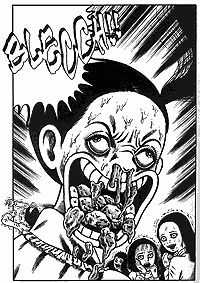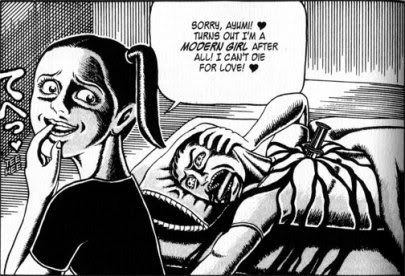It's OK to Laugh!

Octopus Girl Vols. 1-2
(this review first appeared in The Comics Journal #283, May 2007, with different pictures and formatting; note that Dark Horse subsequently cancelled the series one book shy of its four-volume completion)
One of the unique attributes of the continuing manga wave is that it offers readers consistent opportunities for evaluation and reevaluation of seemingly familiar genres. Really, when it comes to a comics environment as sprawling as Japan’s, even years of manga penetration into English-speaking environs can only afford us an obscured viewpoint of the situation, especially where there’s still very few older, establishing works available to read. With a genre as broad as ‘horror,’ our understanding of what the bloody thing could be might shift every few years, depending on which formative works arrive to fill in our educational gaps, and what new(ish) works arrive to pique our interest.
Recently, I’ve been delighted with how much humor can be mixed in to potent manga horror. And I’m not talking moments of black comedy or flashes of rueful wit; I mean loud, bold, nasty fucking humor, cranked up to match the energy of fright. It’ll be no surprise to learn that one of the modern fathers of manga horror, Kazuo Umezu, was also wildly successful in the humor field. But even if you’ve read that somewhere, you really need to actually read something like The Drifting Classroom, which until recently hasn’t been available for English consumption in licensed form, to fully appreciate the caffinated, nervy mix of laughter and dread that a talent like Umezu can manage.
You can argue that Umezu’s target audience was nominally children, and he might have felt he needed to be as tonally hyperactive as possible to keep their attention, but I find the final result to be nevertheless effective, and it’s obviously been carried forward by later artists. Who can forget the images of giant walking sharks with scuttling legs storming the land in Junji Ito’s Gyo? I can still recall a handful of panels where a pair of police officers confront a hammerhead shark on the streets, the sheer absurdity of the situation never less than obvious, yet the stinking primal dread of aquatic monsters suddenly crawling up onto land to eat us actually somewhat enhanced by the reality-gone-wrong madness of it. A big walking shark wriggling its unexpressive way down a small house’s hallway is really funny, especially with the detail Ito invests in it, but you’ll never not be disquieted by the action.

But then there’s works like Octopus Girl, that hold themselves out as explicitly comedy and explicitly horror, rather than simply mining the comedy inherent to the horror, and I have to wonder if its effectiveness has been sapped for me through exposure to the more organically presented laughs of straight-up terror. Certainly there’s nothing that’s not gleefully artificial about this series, the brainchild of writer/artist Toru Yamazaki, who has since attained a non-comics fan following for his television and music work. I haven’t seen any of that stuff (speaking of obscured viewpoints), but I’m aware that he’s openly gay and prone to gender-bending, and there’s absolutely no way to ignore that when reading his comics - there’s a constant sense of playacting present in the work, a deeply mannered evocation of feminine personality traits and shoujo manga gestures that expresses both delight and melancholy, always undermined by oozing rivers of grue and snot and shit.
Maybe the greatest appeal of these two volumes (a third is also currently available) comes from the improvisatory feel that runs through it all. There’s very little that’s fixed in Octopus Girl, save for the presence of the main characters: Takako, a bullied young girl who wakes up one night with her head attached to an octopus’ body, and Sakae, a woman whose own head was attached to the body of a moray eel in a medical experiment. Don’t get caught up on the details, since they don’t matter at all; everything is a pretext to get Yamazaki’s characters into bizarre and occasionally satiric situations, all of them awash in flowing bodily fluids, usually spilt by the heroines. These ladies are hardly simple victims; they are also vengeful, violent, vain, and vulgar.
In one chapter, Takako enters a beauty pageant and quickly sets about eliminating her competition. One girl gets centipedes in her dress, another a giant octopus leg down her throat. All throughout, Yamazaki expertly captures the grinning vapidity of idol expectations through carefully rendered facial expressions and gestures so thoroughly determined they seem like a form of dance, before undermining the whole thing with vivid, detailed depictions of screaming faces and boils forming on skin. Only in fear do most of citizens of Yamazaki’s world fully express themselves; the artist generally renders them flatly, and with little vigor. Takako and Sakae, however, are constantly expressive. Yamazaki is talented at aping the visual conventions expected from drawings of pretty young girls, but one gets the sense he’s built up that skill mainly for the purposes of subverting such expectations with copious bad taste.

One occasionally gets the feeling that things like Yamazaki’s gag strips toward the back of vol. 2, about Disney fairytale features being ruined by bodily necessities (Sleeping Beauty has bad breath, Cinderella’s feet stink), express the same point with far less fuss, but there’s some obvious pleasures to be found in his heroines' adventures with a satanic school, or as housekeepers in a sinister mansion, where the artist happily confronts the undercurrents of primal horror genre situations. When Sakae is given the opportunity to marry the handsome (and, it will come as no surprise, sinister) son of a rich woman, her eyes roll back and tears and drool issue from her face, the words “Marriage… it’s… a woman’s purpose!” splashing across the page as she drifts into a typically arch bridal fantasy. When she and Takako confront a crazed murderer who blames her own actions on everyone else’s opinion as to her ugliness, the two roar “Like you couldn’t say the same fucking thing about us, huh?” “You’ve got persecution mania, bitch!” These two are just as bedazzled by cultural and social expectations as everyone, but they’re not about to feel sorry for themselves, which is as close to a message as this series gets.
And yet, there’s an underlying weakness to some of Yamazaki’s work; every so often in these pages, he’ll suddenly attempt a lunge into ‘pure’ horror, and inevitably fail. The problem is that his humor (and indeed, the very personality of his work) is so reliant on an artificial, easy-to-undermine construct of what is ‘acceptable,’ that his seemingly genuine efforts also inevitably come off as jokes, and clanking, mistimed ones at that. Or maybe he actually is trying to tell jokes, and they’re just so bad that I can’t even be sure what they are. I don’t know what else to make of a story like that of a man who’s confronted with a choice between saving the life of either his wife or his soon-to-be-born child, and begs God to take his life instead, prompting his shriveling into a lifeless corpse. Or that of a family stuck in a falling elevator, the father so intent on not allowing his clan to die that he mystically has his own body broken into so many pieces that it's as if all the wounds of his family have been brought onto him. This is chain e-mail caliber storytelling, so dumb that you don’t want to believe Yamazaki is now trying to be serious, yet so lame you don’t want to admit how shitty his jokes have gotten.
This, I think, is what separates Yamazaki from the likes of Umezu and Ito. He’s got a lot of obvious (if particular) talent, and his sense of aesthetic mission is clear. But he can’t ever quite dedicate himself to the more delicate brutalities of those who divine comedy from horror, though it seems he’d like to. There’s value to these books, but the reader’s enjoyment may hinge on whether they want their horror laced with comedy, or their comedy charged with revulsion. The latter can only be comedy-horror. From our ever-narrowed vantage, the former can be simply a richer horror.

<< Home